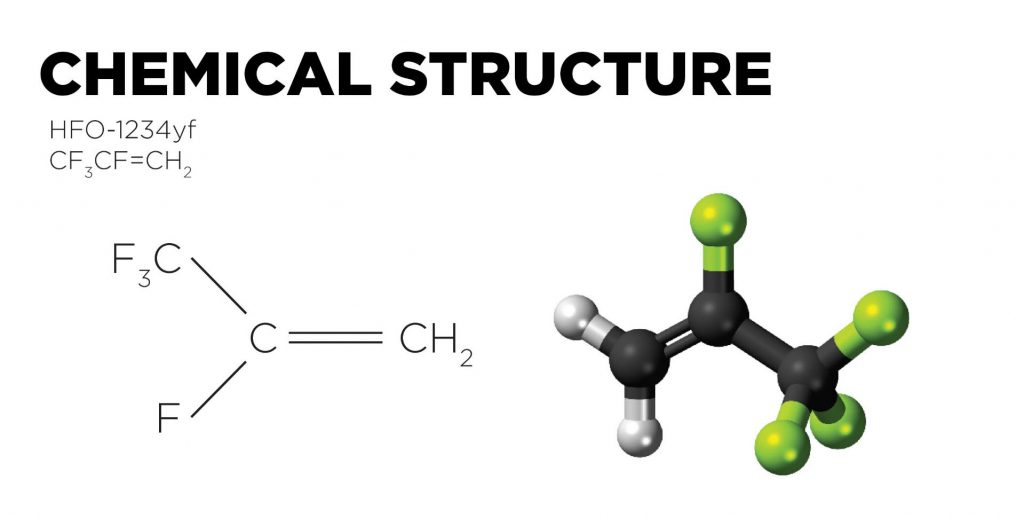HFO and HC (Hydrocarbon) refrigerants, often referred to as the fourth generation of the 21st refrigerants, are efficient and environmentally friendly refrigerants that carry several similarities and differences. One common difference is that HFOs have a lower flammability than Hydrocarbons.
So, why are HFO refrigerants less flammable than hydrocarbon refrigerants?
We’ll provide an in-depth answer to this question in this article. So, let’s get right into it.
The basic explanation why HFO refrigerants are less flammable than hydrocarbons is simply because of their different chemical structures. HFOs contain fluorine, which slows down flammability, while carbon present in the hydrocarbon is reactive and oxidizes easily when exposed to fire or air pressure to create Carbon (IV) oxide, water, and heat.
Let’s dig deeper!

Source: United States Environmental Protection Agency
HFO vs. HC: How Their Chemical Structures Are Different
HFOs (hydrofluoroolefins) are unsaturated organic compounds; hence, the reason we refer to them as olefins or alkenes. Common examples of HFOs include R1234YF, R-1234ze, and R454B.

These compounds consists of three components: hydrogen, carbon, and fluorine. They are different from HFC refrigerants because they contain at least one double bond between the carbon atoms. This is what causes them to be unsaturated.
Here’s a chemical structure of one of the most popular HFO refrigerant, R1234YF.

When exposed to air, most HFO refrigerants are mildly flammable at 20 oC, which is the reason why they have an A2L classification. The presence of fluorine slows down the flammability of the refrigerant.
However, it’s good to note that as the temperature and humidity increases, the refrigerant will become highly flammable, and can easily cause a fire. This is because – although fluorine is a non-flammable gas – it can become an energetic oxidizing agent when exposed to a large amount of minerals or organic product.

Hydrocarbons, on the other hand, are highly flammable since they contain hydrogen and carbon atoms in their structure. When you expose a hydrocarbon to oxygen, the carbon will oxidize to form heat, carbon IV oxide, and water. Hence, it’s the reason why ammonia leaks (which is a hydrocarbon) are dangerous.

Source: energyeducation.ca
Can You Use HFOs in Place of Hydrocarbons?
Now that we understand why HFO refrigerants are less flammable, should we shift to using HFOs only?
From our standpoint, both HFOs and Hydrocarbons are becoming popular because both are non-toxic refrigerants than HFCs, HCFCs, and CFCs.
Many governments and manufacturers are adopting HFOs and Hydrocarbons in newer devices because both have zero ozone depletion potential and a low global warming potential (although hydrocarbons have a zero GWP).
So, is replacing hydrocarbons with HFOs reasonable? The answer to this question will depend on so many factors. One of them is how you intend to use the refrigerant. An HFO refrigerant would be suitable in certain applications while it may not be ideal in certain conditions.
A good example is in mild-freezing applications (between zero and -120C). HFO refrigerants would be the best option to hydrocarbon refrigerants because there’s low cost involved in charging and maintaining a HFO-based system than using a system that uses a hydrocarbon such as ammonia.
Here’s a video resource that would better explain this:
Besides this, since hydrocarbons are highly flammable, it would be suitable in applications where the unit requires little amounts of the refrigerant.
You can read more on the uses of hydrocarbons in this article.
For instance, most residential refrigerators use hydrocarbons because they don’t require much of it. This is because there’s less risk of damage in case the hydrocarbon leaks into the environment or causes a fire.
Safety Considerations When Using Hydrocarbon Refrigerants
Although hydrocarbons are popular, some people don’t know how to handle flammable refrigerants safely during installation, maintenance, and when replacing them in systems that used non-flammable refrigerants previously.
In a document prepared by the Government of Western Australia on the Safety Considerations When Switching to Flammable Refrigerants, the authority suggests the following:
- Manufacturers, supplies, and importers should label the equipment appropriately: They should disclose all the information pertaining to the refrigerant in use, and how a technician should handle it using Safety Data Sheets and labels.
- The technician should investigate if the equipment can use flammable refrigerants before charging it into the system: Some systems may only suit non-flammable refrigerants, and if you don’t check this, the refrigerant can leak or corrode the system, causing a fire.
- Technicians should keep a record of maintenance: For instance, if the technician charges a flammable refrigerant into the system, he or she should indicate to prevent an accident when someone new comes to inspect and maintain the system.
- Flammable refrigerants should only be handled by licensed and trained personnel: These experts have enough technical ability and required equipment to handle such refrigerants and can explain the risk of these refrigerants to the consumer.
Conclusion
That’s it for today! We hope the article answers the question, “Why are HFO refrigerants less flammable than hydrocarbon refrigerants?” properly. As we have seen, the reason draws down to their different chemical structures. If you have any other question about this, be sure to reach out to us.